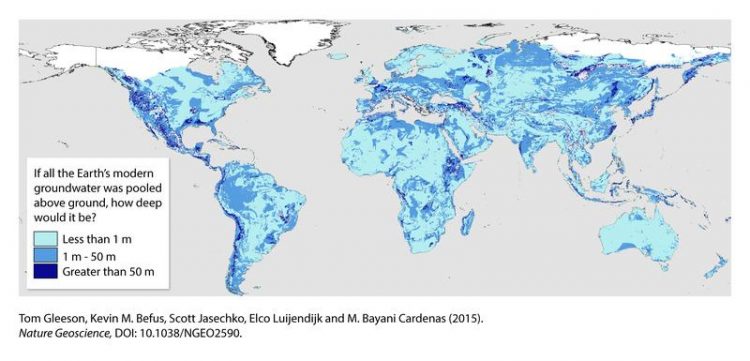First quantification of Earth’s groundwater

Model: The amount of 23 million cubic kilometers of groundwater is enough to cover the global land surface in a layer 180 metres deep. Photo: University of Victoria
An international team of scientists with participation from the University of Göttingen has produced the first data-driven estimate of the Earth’s total supply of groundwater.
The study shows that the total volume of groundwater of any age is about 23 million cubic kilometres. However, less than six percent of the total amount is modern groundwater that is replenished within a human lifetime.
Some of the largest volumes of modern groundwater are in the Amazon Basin, the Congo, Indonesia, and in mountain chains like the Rocky Mountains, the least amount is not surprisingly in more arid regions such as the Sahara.
The study was conducted by the Universities of Victoria, Calgary (both Canada), Austin (Texas) and Göttingen (Germany) and published in Nature Geoscience.
Groundwater is one of the planet’s most exploited and most precious natural resources. Around the world, there is increasing demand to know how much we have and how long before it is tapped out.
“The amount of 23 million cubic kilometers is enough to cover the global land surface in a layer 180 metres deep,” explains Dr. Elco Luijendijk from Göttingen University’s Geoscience Centre.
“Although the volume of modern groundwater may appear small at first glance, it is still much larger than all other components of the active hydrological cycle such as water in rivers, lakes, and the atmosphere.”
The study combined measurements of radioactive tritium introduced to the groundwater by nuclear tests in the 1950’s with computer models of groundwater flow in the upper two kilometres of the subsurface.
“Knowing the volume of modern groundwater is important because it is a more renewable resource than older stagnant groundwater,” says Dr. Luijendijk. “However, modern groundwater is also more vulnerable to climate change and contamination by human activities.”
Original publication: Tom Gleeson et al. The global volume and distribution of modern groundwater. Nature Geoscience 2015. Doi: 10.1038/ngeo2590.
Contact:
Dr. Elco Luijendijk
University of Göttingen
Faculty of Geoscience and Geography
Geoscience Centre – Department of Structural Geology and Geodynamics
Goldschmidtstraße 3, 37077 Göttingen, Germany
Phone: +49 551 39-14269
Email: eluijen@gwdg.de
Web: http://www.uni-goettingen.de/en/dr-elco-luijendijk/487484.html
http://www.uni-goettingen.de/en/dr-elco-luijendijk/487484.html
Media Contact
All latest news from the category: Earth Sciences
Earth Sciences (also referred to as Geosciences), which deals with basic issues surrounding our planet, plays a vital role in the area of energy and raw materials supply.
Earth Sciences comprises subjects such as geology, geography, geological informatics, paleontology, mineralogy, petrography, crystallography, geophysics, geodesy, glaciology, cartography, photogrammetry, meteorology and seismology, early-warning systems, earthquake research and polar research.
Newest articles

Bringing bio-inspired robots to life
Nebraska researcher Eric Markvicka gets NSF CAREER Award to pursue manufacture of novel materials for soft robotics and stretchable electronics. Engineers are increasingly eager to develop robots that mimic the…

Bella moths use poison to attract mates
Scientists are closer to finding out how. Pyrrolizidine alkaloids are as bitter and toxic as they are hard to pronounce. They’re produced by several different types of plants and are…

AI tool creates ‘synthetic’ images of cells
…for enhanced microscopy analysis. Observing individual cells through microscopes can reveal a range of important cell biological phenomena that frequently play a role in human diseases, but the process of…





















